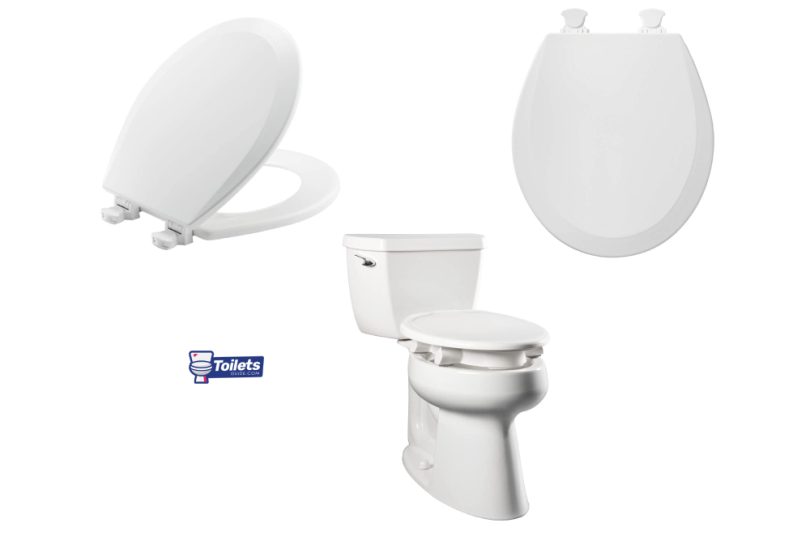As the oldest and largest manufacturer of toilet seats, Bemis always delivers quality. The good news is their seats are also simple to remove when you need a replacement.
There are several ways that Bemis seats are fastened, so how is yours fastened? Let’s take a look.
Table of Contents
How to Remove a Bemis Toilet Seat?
Step 1: Gather the tools
- Screwdriver
- Sharp object to penetrate through the gunk
- Combination wrench
Step 2: Locate the fasteners
Fasteners for a toilet seat are usually hidden beneath covers next to the hinges. It’s possible to find the fasteners underneath the toilet side aligned with those on top.
Step 3: Unscrew the bolt
You should open all fasteners anti-clockwise and you will need a specific screwdriver depending on the design of your fastener.
Step 4: Scrub the rim
Fasteners aren’t accessible during the regular cleaning process, which means they may be very dirty. Having a sharp object that can penetrate them can be very useful.
Step 5: Remove the cover according to the design
a) Top-Tite® toilet seat
Bemis Top-Tite® fasteners resemble traditional toilet seats with bolts and nuts. Made from plastic, the heads fracture once you gain proper torque during installation. You can remove the seat by following these steps.
Step 1: Make sure the bolt head is visible. Remove the bolt caps behind the seat.
Step 2: Take hold of the bottom nut. The plastic nut at the bottom can be secured with a screwdriver or combination wrench. In some cases, you can use your hand.
Step 3: The fastener needs removing. Use a socket or screwdriver to undo the fasteners. You can unscrew the bottom part by holding it with your hand.
Step 4: Take the seat off.
b) Sta-Tite toilet seat
A bolt penetrates into the bottom side of the toilet bowl to hold the Bemis toilet seat in place. The toilet seat needs to be taken out completely for thorough cleaning.
Sta-Tite’s toilet seats take advantage of the modern technology, being more user-friendly than others. Check out the video –
How to Remove a Bemis Toilet Seat with Classic Fasteners
Step 1: Gather tools
- Pliers
- Wrench set
- Socket wrench that has a deep-well socket
Step 2: Find the fasteners
You should find the fasteners under the covers beside your toilet seat’s hinges. In addition to the fasteners above the toilet. Often, they coincide with those on top of the toilet.
Step 3: Identify the type of fastener heads
Choosing the right fastener head type is essential. Headers are most available in three types; hexagonal, flathead, and Philips. Hold the washer at the bottom end with pliers or with your hand if some are larger.
Step 4: Secure the bottom nut
You need to determine the type of bottom nut you have since bottom nuts also come in different styles. If it is hexagonal or wing-shaped, you might have to use your fingers or a wrench. It also depends on how easy it is to open.
Step 5: Remove the bolt
An anti-clockwise rotation of all fasteners is best. Depending on the design of your fastener, you will need a particular screwdriver.
Step 6: Clean the rim
Fasteners in locations that are inaccessible when cleaning may have grime on them. Pointy objects can be useful in reaching these areas.
How to Remove Bemis Seat Bolts?
Method 1: Using a deep-well socket for metal seat bolts
Step 1: Gather tools
- Pliers
- Socket wrench with deep wall socket
- ½ in socket
Step 2: You can loosen some metal bolts with pliers. To do this job, you need a socket wrench that has a deep-well socket. The standard socket size is 1/2-inch.
Step 2: The deep socket grips the nut tightly over the long bolt. A metal bolt usually doesn’t have a flip-open cover. Turning the nut counter-clockwise will do the job.
Step 3: Twist as hard as possible. For brass bolts or steel that has corroded, they may break, which is ok.
Method 2: The drill option for metal seat bolts
Step 1: Gather tools
- Safety glasses
- Drill
- Drill bit collection
Step 2: Use a 1/16-inch drill bit. Start drilling at the nut-bolt intersection. Drill 1/4 inch. through the bolt.
Step 3: After drilling the hole, enlarge it by 1/8 of an inch. Next, use a 3/16-inch bit. After that, try again with the socket wrench. It’s now your goal to break off the bolt instead of unscrewing the nut.
If the bolt does not break, keep expanding the hole. The bolt will eventually break if you keep expanding the hole.
Step 4: Pull the seat off
Method 2: For plastic seat bolts
Step 1: Gather tools
- Combination wrench or socket
Step 2: Remove the bolt head
Step 3: Remove the bolt caps behind your seat
Step 4: Hold the bottom nut. Use a combo wrench or socket to keep the plastic nut in place
Step 5: Take out the fastener
Step 6: Remove the seat
How to Remove a Slow-Close Toilet Seat?
The process is easy. Check out the video for help.
How to Remove a No-Visible Toilet Seat Bolt?
The bolt that holds the seat in place is visible on the top side when you remove the caps. Below the toilet, some bolts protrude. Wingnuts will help tighten these bolts.
As soon as the nuts are steady, use your pliers to hold them and then take the bolt off with the screwdriver.








Leave a Comment